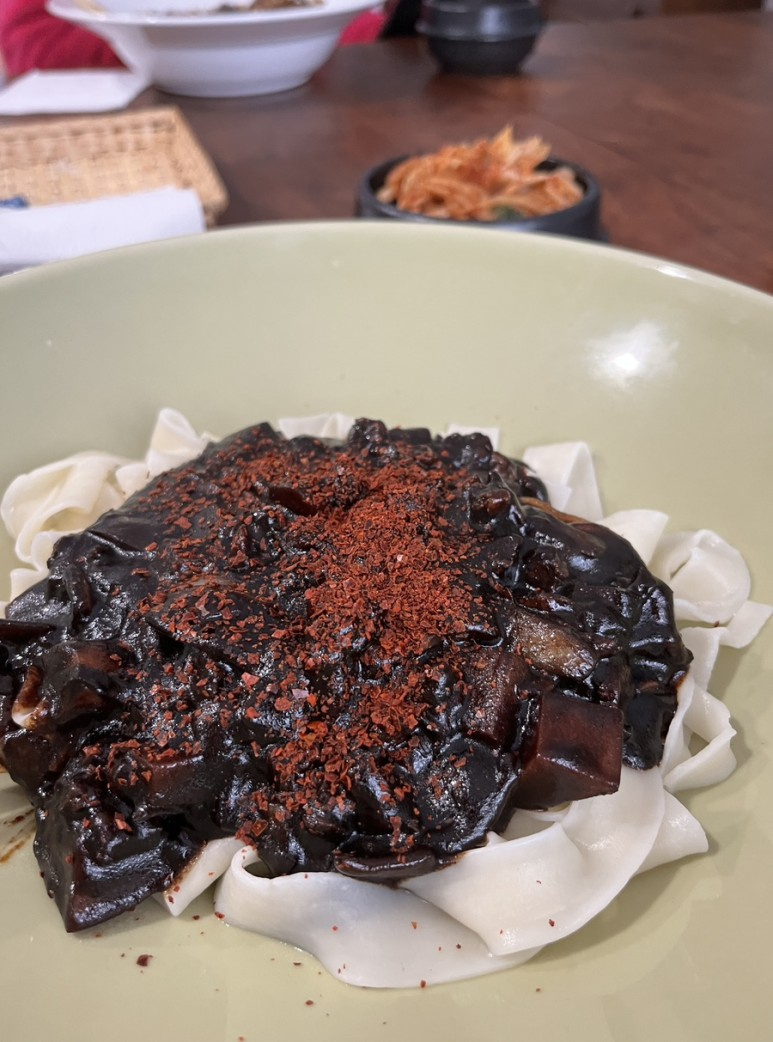Rich Beef Jjajangmyeon with Knife-Cut Noodles (Dosakmyeon)
A Perfect Harmony of Chewy Dosakmyeon and Hearty Beef Jjajang Sauce

Making Jjajangmyeon at home is wonderful because you can customize the ingredients to your exact taste! Today, I made a rich Jjajang sauce generously packed with beef, served over chewy Dosakmyeon noodles for a truly satisfying meal.
Main Ingredients- Dosakmyeon noodles, 2 servings
- Beef (ground or finely chopped) 400g
- Cooking oil 3 Tbsp
- Scallions 4 stalks
- Minced garlic 1 Tbsp
- Soy sauce 2 Tbsp
- Onion 1
- Potatoes 3
- Sugar 2 Tbsp
- Stir-fried black bean paste (Chunjang) 3 Tbsp
- Water 2 cups (approx. 400ml)
- Red pepper flakes, a pinch (optional)
Thickening Slurry- Cold water 5 Tbsp
- Cornstarch (or potato starch) 2 Tbsp
- Cold water 5 Tbsp
- Cornstarch (or potato starch) 2 Tbsp
Cooking Instructions
Step 1
First, let’s prepare the base for the Jjajang sauce. If you’re using water instead of anchovy or kelp broth, consider using vegetable broth for extra flavor. Be generous with the beef you choose! (Black Angus chuck roast is recommended.) Place the finely chopped beef in a pan with 3 Tbsp of cooking oil over medium heat. Add the chopped scallions and 1 Tbsp of minced garlic, and stir-fry until fragrant. Sautéing the scallions in oil is a crucial step.

Step 2
Once the beef is partially cooked, add 2 Tbsp of soy sauce. Pour it around the edges of the pan and stir-fry it with the other ingredients. The soy sauce will caramelize slightly, adding depth to the flavor.

Step 3
Now it’s time to add the vegetables. Add 1 coarsely chopped onion and 3 potatoes, diced into about 1cm cubes. Stir-fry them until the potatoes begin to soften and become slightly translucent.

Step 4
As the vegetables soften, add 2 Tbsp of sugar to enhance the sweetness and stir-fry everything together. Sugar helps to bring out the savory flavors of the vegetables.

Step 5
Now for the star ingredient: add 3 Tbsp of store-bought stir-fried black bean paste (Chunjang) and stir-fry it thoroughly with all the ingredients. Ensure the salty and rich flavor of the Chunjang is well distributed.

Step 6
Continue to stir-fry over low heat for a few minutes, allowing the flavors to meld together beautifully. This process deepens the taste of all the ingredients, creating a texture similar to ‘Ganjjajang’ (dry Jjajang).

Step 7
At this stage, you have a ‘Ganjjajang’ style sauce, focusing on the natural flavors of the ingredients. You can enjoy it as is if you prefer a drier style.

Step 8
To create a more traditional Jjajang sauce consistency, gradually add about 2 cups (400ml) of water while stirring to reach your desired thickness. Taste and adjust seasoning: add more sugar if you prefer it sweeter, or more Chunjang if you want it saltier. If it’s too salty, you can add a little more water. Don’t worry too much about exact measurements; focus on achieving your preferred taste and consistency.

Step 9
Once the Jjajang sauce is simmering, it’s time to add the thickening slurry. In a small bowl, mix 5 Tbsp of cold water with 2 Tbsp of cornstarch until smooth. Gradually pour this mixture into the simmering Jjajang sauce while stirring constantly. Cook for another minute or two until the sauce thickens to your liking. Keep stirring to prevent lumps or sticking to the bottom.

Step 10
Now, let’s cook the noodles. Today, I’m using fresh Dosakmyeon noodles. Dosakmyeon are knife-cut noodles known for their wonderfully chewy texture.

Step 11
Bring a large pot of water to a rolling boil. Add the fresh Dosakmyeon noodles and stir gently to prevent them from sticking. As the water comes back to a boil, add 1 cup of cold water. When it boils again, add another cup of cold water. For the third boil, add the final cup of cold water. Once it boils one more time, immediately drain the noodles. This process of adding cold water multiple times helps to achieve a perfectly chewy noodle texture. For Jjajangmyeon, it’s best to use the noodles warm and not rinse them with cold water. This allows the Jjajang sauce to cling to the noodles better, making each bite more flavorful.

Step 12
Place the warm, chewy Dosakmyeon noodles in a bowl. Generously ladle the hot, rich Jjajang sauce over the top. Don’t be shy with the sauce; make sure it covers the noodles beautifully.

Step 13
I usually only make two servings, but today my daughter visited from out of town, so we made three. Cooking together with family, even when busy, fills the time with such happiness and a sense of accomplishment.

Step 14
Finally, sprinkle a pinch of red pepper flakes on top according to your preference for a touch of heat. Your delicious Beef Dosakmyeon Jjajangmyeon is ready! Enjoy!



